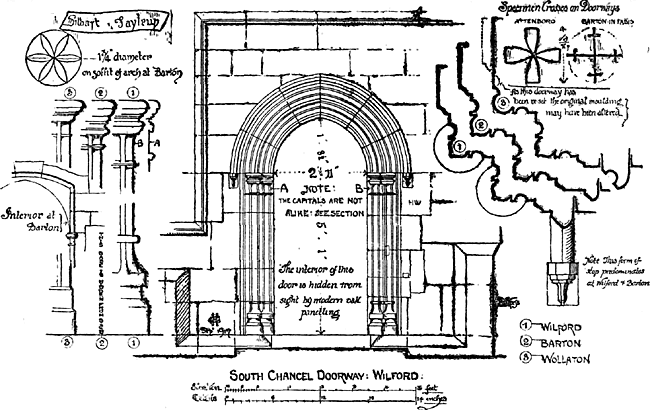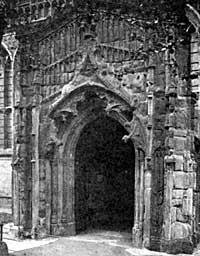Among the smaller doorways of the period, the south chancel doorway at Gedling may be mentioned. This exhibits a further stage of development, as the capitals here have " stiff leaf" foliage carved on the bell.
In the 14th century, several doorways were built of graceful and pleasing proportions, having delicate nook-shafts worked on the jamb-stones, and refined arch-mouldings. The inner doorway at Edwinstowe, c. 1350, may be cited as an example, see Vol. XVIII.
Not a little interest attaches to the dripstone terminations of this period. Occasionally they are formed with a short return of the moulding, but more frequently with corbel heads which are sometimes grotesque in form. At other times they are beautiful carvings meant to commemorate a patron saint, a benefactor, or the reigning sovereign; or, the figure may be a not too flattering presentment of a church dignitary: and when, as frequently transpires, the features or insignia can be identified, they help to elucidate the date of erection. For instance, the corbel heads to a doorway on the south side of the choir at Southwell, are said to represent Henry IV. and his Queen, because of the SS collar worn by the King. Again, the north door at Clifton, generally attributed to the 14th century, was, I think, more probably inserted when the chancel also was rebuilt (1475), for it has on the west side, the mitred head of the rector of that time, who had been "Bishop of the Isles"—Sodor and Man, 1448-1454,—and on the other side, the "handsome face" of our "comely King" Edward IV., who was then "seated on the English throne."
These may be but conjectures; nevertheless, such carvings are full of interest and worthy of study, if only as illustrations of the costume and head-dress of the period.
A characteristic ornament of this period is the "four-leaf" flower. It occurs on the before mentioned north doorway at Clifton, and on the west doorway at Scarrington, where may also be seen, what is, I believe the only specimen of the "ball-flower" enrichment to be found on a doorway, in this county, although in other districts it was profusely employed.
Another suggestive line for study is the great similarity of the work, not only in neighbouring churches, but also in churches remote from each other.

For instance, the south chancel doorways at Barton-in-Fabis, Wilford, and Wollaton, are identical in size, and in the profiles of their mouldings (see line drawing); and further the stones are all out of the same quarry, so that one cannot escape the conviction, that they were successively wrought by the same craftsmen. This may be due to monastic or clerical influence, or it may be the work of a "Hal o'the Draft" (vide Kipling), who hailed from the district. Anyway, it is worthy of notice that on the eastern soffit of the arch at Barton, there is a tablet inscribed in old English letters, with a good old English name—"Sifoart Sagltnr"—and a sex-foil circle, struck with the point of his callipers. The lettering (quarter inch) is only slight and somewhat confused with the striation of the stone, but I am inclined to think it is original, as there is correspondence between it and an inscription (half inch) on the base moulding of the eastern pier of the nave arcade "Hic fuit Henricus Chilom." According to Torre, Ric Killom (i.e. Kelham) was Rector 1408-1415.

St Mary's Nottingham. South porch.
During the reign of Richard II., an embattled porch was built at St. Mary's, Nottingham. Owing to the perishable nature of the stone (Gedling), and the abortive modern attempts to restore it with Roman cement, the details have suffered partial eclipse; but the remains are sufficient to enable us to realize its beauty, when in a pristine condition. The outer ogee arch is crocketted and finialed; the inner arch is cinquefoiled, and each foil is again trefoiled, and cusped, with delicate carvings of leaves and flowers in the spandrils, and at points where arcs of the featherings unite. Large leaves spring from behind the hanging arches, and spread over the point of intersection in an ingenious manner. The entrance is flanked with graceful buttresses, two on either side, and the gable is enriched with two tiers of cusped panelling. There is a canopied bracket on either side of the inner doorway, but no trace remains of the holy-water stoup, or of the image of the Virgin, which they were evidently designed to carry. At almost every intersection of the mouldings, and in all the hollows, delicate carvings are introduced.
At this period, and for some time after, porch roofs were formed entirely of stone, within and without. The ceiling was either a plain pointed barrel vault, or a vault carried on a number of arched ribs, not very wide apart, the outer roof being composed of slabs of local stone, set in overlapping courses. At St. Mary's, the latter form was adopted, the ribs taking the form of straight-sided arches, the spaces between being thrown into panels with arched and cusped heads, while the side walls are strengthened outwardly by an array of tiny buttresses to counteract any thrust.
This porch had not long been completed, when a new steeple was commenced at the adjoining parish church of St. Peter (c. 1400). The contour and exigency of the site were not favourable to a south porch, and so, as not infrequently happened under like circumstances, the lower stage of the new steeple became the main entrance to the church. The doorway is set between slender buttresses which are finished with carved pinnacles ; the mouldings of the pointed arch are continued down the jambs without any intervening caps; a crocketted hood-moulding springs out of the buttresses and spreads into an ogival head, crowned with a carved finial. On either side of the arch, a canopied niche was made to shelter images of SS. Peter and Paul, in whose honour the church was originally dedicated. Like the porch of the mother church, this doorway is now weatherworn and despoiled of much of its charm.
The village church of St. Martin, Bilborough has a south porch with an inner and outer doorway, very similar in design to the last named, save that slender shafts appear in the jamb moulding, and carved pateras in the arch, while the flanking buttresses to the outer doorways are incipient, and take the form of shafted finials with embattled heads, rising from the crowns on the corbel heads of king and queen on either side.
The inner doorway of the neighbouring church of St. Patrick, Nuthall, belongs to the same period (c. 1400), and is almost identical in design. The hand of the restorer has been busy at Bilborough, and as a consequence, the porch, like so many others in the vicinity, is now covered by an alien roof; for, while the stone water-tabling still remains to determine the pitch, the collar of the timber roof has caused the shafted finials of the inner doorway to be cut away, to make room for it. But if we would see the type of roof once so common in the village churches of this district, we have only to go forward to Strelley, where the porch remains as it was built in 1356. It has a pointed barrel vault, surmounted by a roof of stone slabs. Angle buttresses are carried up almost as high as the dripping eaves, when they are diminished, and become tall octangular pinnacles with embattled heads. The high-pitched gable has a graceful cross at the apex, and although the spandril presents a fair surface, where we might look to find an ornate niche, it is left void, for the church is dedicated to All Saints, and a purposeless niche would have been an abomination to the builders of that period. It was not until a century later that anomalies began to creep in, and thus we find that the 15th century porch at All Hallows, Gedling, (which was built after the earlier dedication to SS. Peter and Paul, as represented by the images at the west end, had been changed), has a very ornate niche, decorated with heraldic shields, &c., which appears never to have been tenanted.
(1) The impost and arch mouldings correspond with the north pier-arcade (1145-1190).
